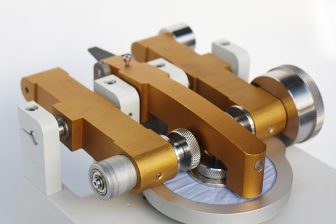The organic coating is applied at uniform thickness to a plane, rigid panel and, after curing, the surface is abraded by
rotating the panel under weighted abrasive wheels.

Abrasion resistance is calculated as loss in weight at a specified number of abrasion cycles, as loss in weight per
cycle, or as number of cycles required to remove a unit amount of coating thickness.
Significance and Use:
Coating on substrates can be damaged by abrasion during manufacturing and service. This test method has been useful in evaluating the abrasion resistance of attached coatings. Ratings produced by this test method have correlated well with ratings produced by the falling abrasive values in Test Methods D968.
For some materials, abrasion tests utilizing the Taber Abraser may be subject to variation due to changes in the abrasive characteristics of the wheel during testing. Depending on abradant type and test specimen, the wheel surface may
change (that is, become clogged) due to the pick-up of coating or other materials from test specimens and must be refaced at more frequent intervals as agreed upon by the interested parties. To determine if more frequent refacing is required, plot the total weight loss every 50 cycles. If a significant negative change in slope is observed prior to 500 cycles, the point at which the slope changes determines the refacing frequency.
 Abrasion resistance is calculated as loss in weight at a specified number of abrasion cycles, as loss in weight per
cycle, or as number of cycles required to remove a unit amount of coating thickness.
Significance and Use:
Coating on substrates can be damaged by abrasion during manufacturing and service. This test method has been useful in evaluating the abrasion resistance of attached coatings. Ratings produced by this test method have correlated well with ratings produced by the falling abrasive values in Test Methods D968.
For some materials, abrasion tests utilizing the Taber Abraser may be subject to variation due to changes in the abrasive characteristics of the wheel during testing. Depending on abradant type and test specimen, the wheel surface may
change (that is, become clogged) due to the pick-up of coating or other materials from test specimens and must be refaced at more frequent intervals as agreed upon by the interested parties. To determine if more frequent refacing is required, plot the total weight loss every 50 cycles. If a significant negative change in slope is observed prior to 500 cycles, the point at which the slope changes determines the refacing frequency.
Abrasion resistance is calculated as loss in weight at a specified number of abrasion cycles, as loss in weight per
cycle, or as number of cycles required to remove a unit amount of coating thickness.
Significance and Use:
Coating on substrates can be damaged by abrasion during manufacturing and service. This test method has been useful in evaluating the abrasion resistance of attached coatings. Ratings produced by this test method have correlated well with ratings produced by the falling abrasive values in Test Methods D968.
For some materials, abrasion tests utilizing the Taber Abraser may be subject to variation due to changes in the abrasive characteristics of the wheel during testing. Depending on abradant type and test specimen, the wheel surface may
change (that is, become clogged) due to the pick-up of coating or other materials from test specimens and must be refaced at more frequent intervals as agreed upon by the interested parties. To determine if more frequent refacing is required, plot the total weight loss every 50 cycles. If a significant negative change in slope is observed prior to 500 cycles, the point at which the slope changes determines the refacing frequency.